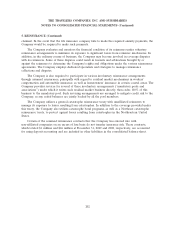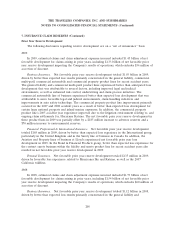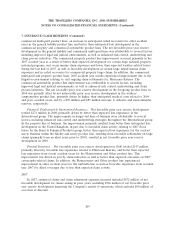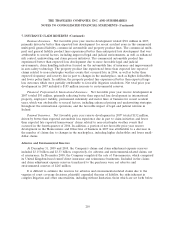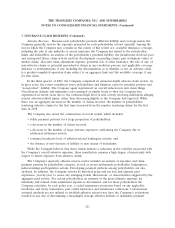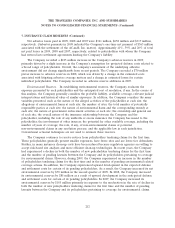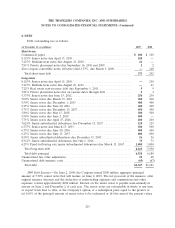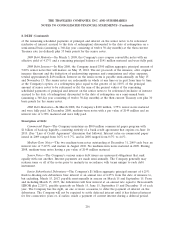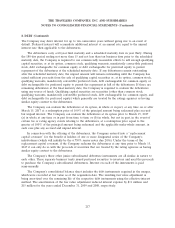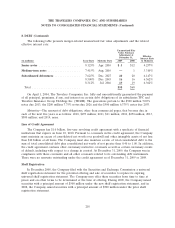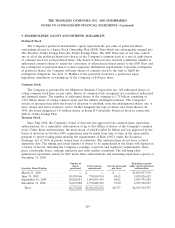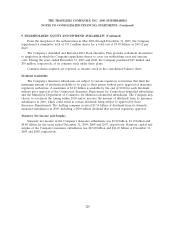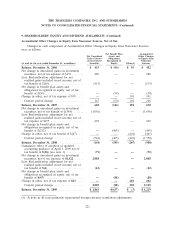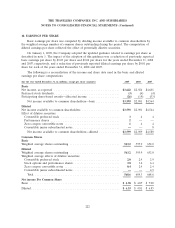Travelers 2009 Annual Report Download - page 224
Download and view the complete annual report
Please find page 224 of the 2009 Travelers annual report below. You can navigate through the pages in the report by either clicking on the pages listed below, or by using the keyword search tool below to find specific information within the annual report.THE TRAVELERS COMPANIES, INC. AND SUBSIDIARIES
NOTES TO CONSOLIDATED FINANCIAL STATEMENTS (Continued)
7. INSURANCE CLAIM RESERVES (Continued)
Net asbestos losses paid in 2009, 2008 and 2007 were $341 million, $658 million and $317 million,
respectively. (Asbestos payments in 2008 included the Company’s one-time net payment of $365 million
associated with the settlement of the ACandS, Inc. matter). Approximately 41%, 59% and 20% of total
net paid losses in 2009, 2008 and 2007, respectively, related to policyholders with whom the Company
had entered into settlement agreements limiting the Company’s liability.
The Company recorded a $185 million increase in the Company’s asbestos reserves in 2009,
primarily driven by a slight increase in the Company’s assumption for projected defense costs related to
a broad range of policyholders. Overall, the company’s assessment of the underlying asbestos
environment did not change significantly from recent periods. The Company recorded a $70 million
pretax increase to asbestos reserves in 2008, which was driven by a change in the estimated costs
associated with litigating asbestos coverage matters and a change in estimated losses for certain
individual policyholders. The Company recorded no asbestos reserve additions in 2007.
Environmental Reserves. In establishing environmental reserves, the Company evaluates the
exposure presented by each policyholder and the anticipated cost of resolution, if any. In the course of
this analysis, the Company generally considers the probable liability, available coverage, relevant judicial
interpretations and historical value of similar exposures. In addition, the Company considers the many
variables presented, such as the nature of the alleged activities of the policyholder at each site; the
allegations of environmental harm at each site; the number of sites; the total number of potentially
responsible parties at each site; the nature of environmental harm and the corresponding remedy at
each site; the nature of government enforcement activities at each site; the ownership and general use
of each site; the overall nature of the insurance relationship between the Company and the
policyholder, including the role of any umbrella or excess insurance the Company has issued to the
policyholder; the involvement of other insurers; the potential for other available coverage, including the
number of years of coverage; the role, if any, of non-environmental claims or potential
non-environmental claims in any resolution process; and the applicable law in each jurisdiction.
Conventional actuarial techniques are not used to estimate these reserves.
The Company continues to receive notices from policyholders tendering claims for the first time.
These policyholders generally present smaller exposures, have fewer sites and are lower tier defendants.
Further, in many instances clean-up costs have been reduced because regulatory agencies are willing to
accept risk-based site analyses and more efficient clean-up technologies. In recent years, the Company
had experienced a decline in both the number of new policyholders tendering claims for the first time
and the number of pending lawsuits between the Company and its policyholders pertaining to coverage
for environmental claims. However, during 2009, the Company experienced an increase in the number
of policyholders tendering claims for the first time and in the number of pending environmental related
coverage actions. In addition, the Company experienced upward development in the expected defense
and settlement costs for certain of its pending policyholders. As a result, the Company increased its net
environmental reserves by $70 million in the second quarter of 2009. In 2008, the Company increased
its environmental reserves by $85 million as a result of upward development in the anticipated defense
and settlement costs for certain of its pending policyholders. In 2007, the Company increased its
environmental reserves by $185 million primarily in response to the moderation in the rate of decline in
both the number of new policyholders tendering claims for the first time and the number of pending
lawsuits between the Company and its policyholders pertaining to coverage for environmental claims.
212


